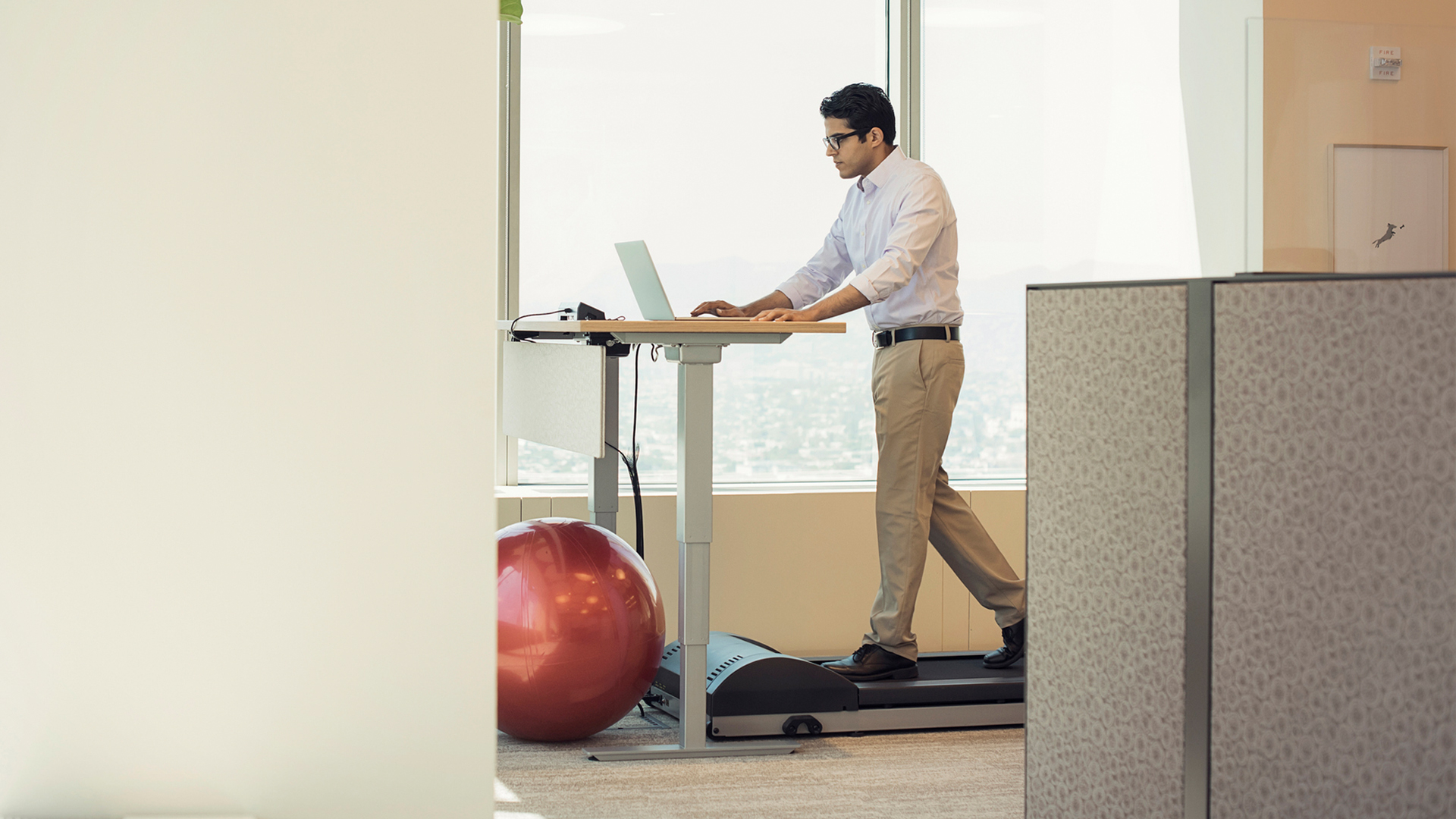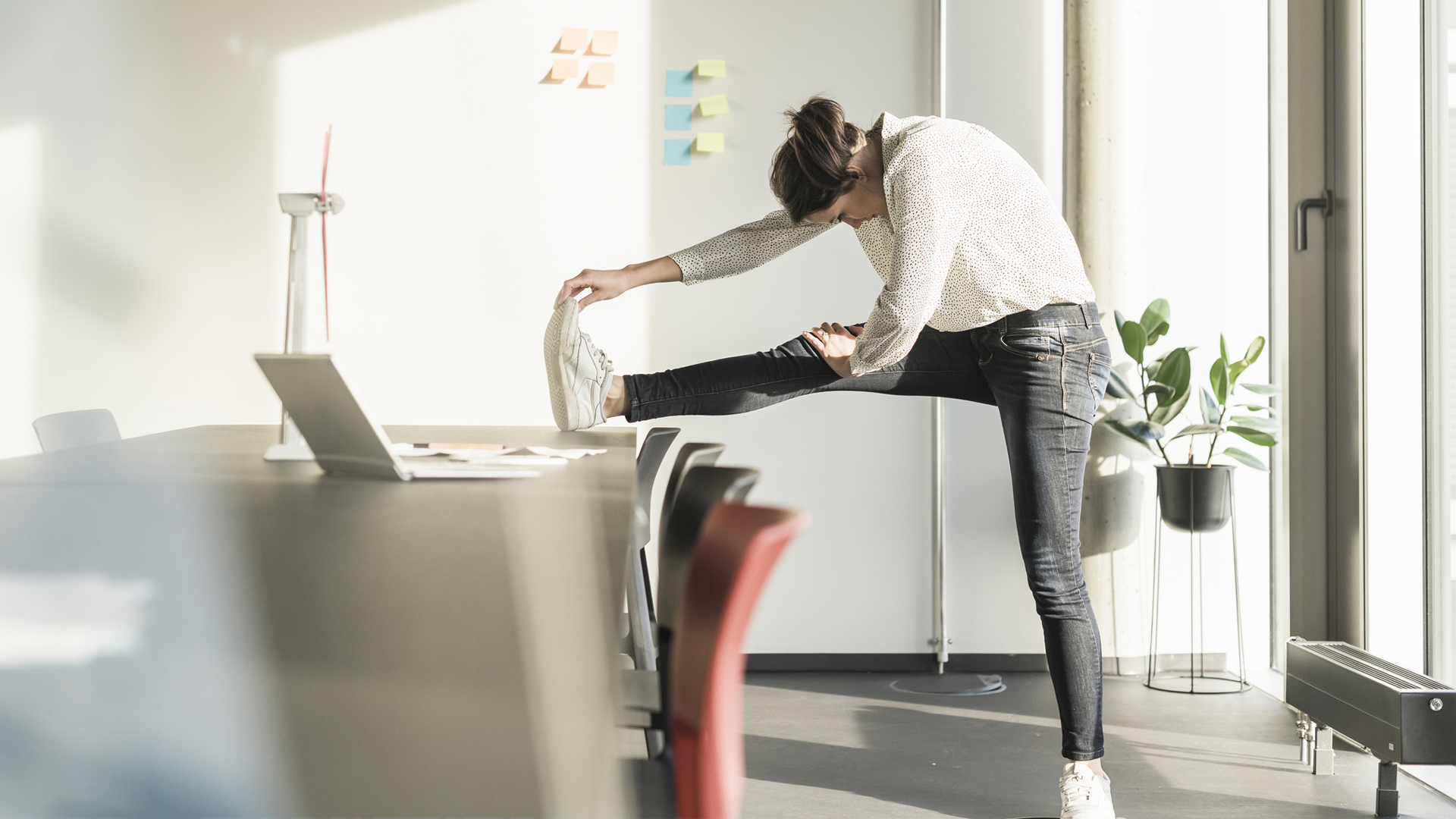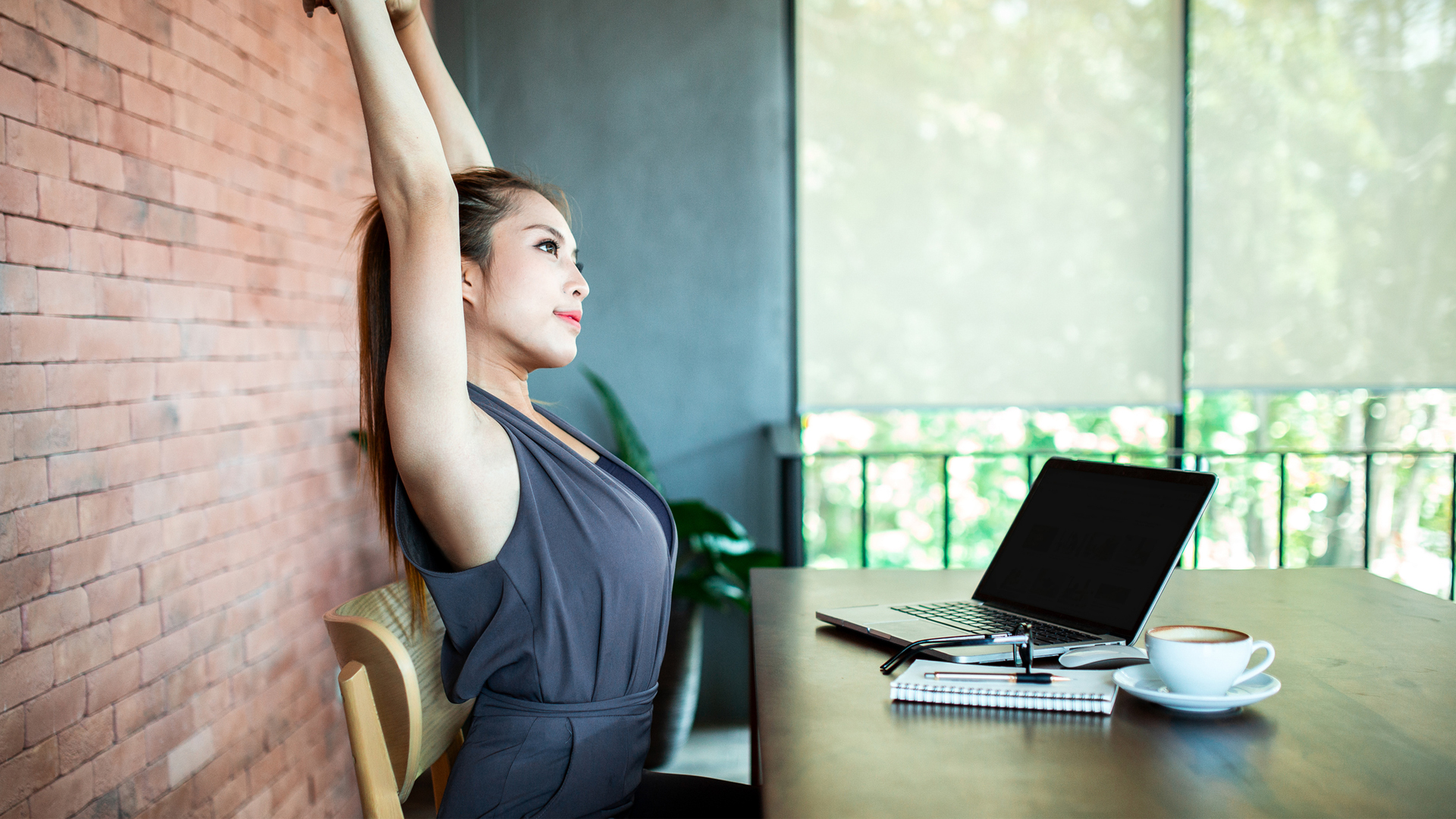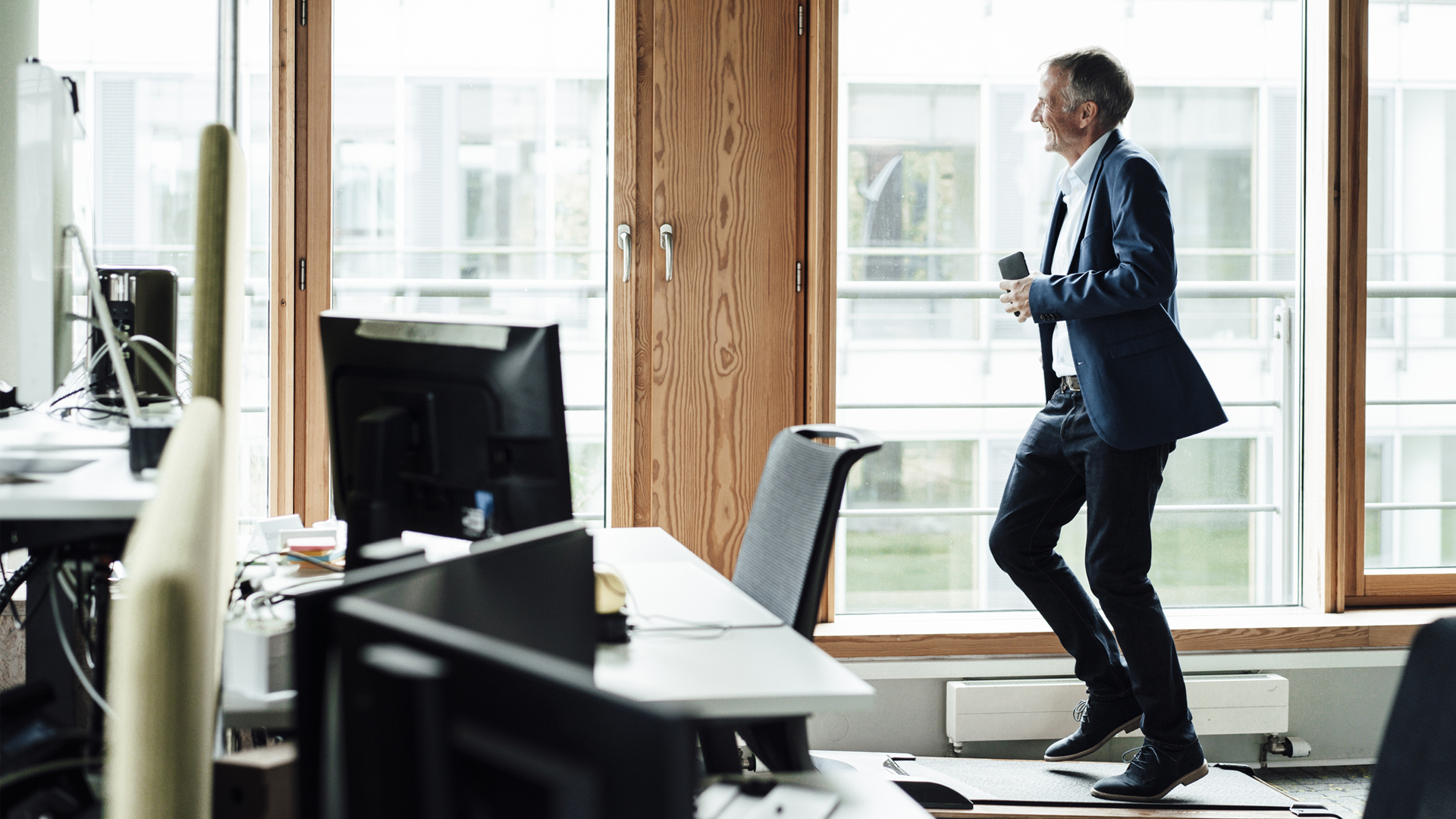What is under desk exercise?
Under desk exercise could be a good way to keep active, for those who spend a lot of time sitting down. Here's how to get started

For people who spend a lot of time seated, under desk exercise could provide a useful solution to counteract the effects that prolonged sitting can bring to our health. Many of us spend around eight hours a day at work. Factor in commuting to and from the office, eating dinner or watching TV in the evening, and the time spent sitting each day quickly mounts up. If this sounds like you, then under desk exercise could bring surprising benefits.
Government guidelines for adults recommend between 150 and 300 minutes a week of moderate-intensity aerobic exercise (or 75 to 150 minutes of vigorous-intensity aerobic exercise) for any substantial health benefits. It also advises 'muscle-strengthening activities of moderate or greater intensity that involve all major muscle groups on two or more days a week'.
Fitting all this in while you're working takes a bit of planning, but if you do have the advantage of some space you may want to take a look at the best walking treadmills or the best exercise bikes.
If you'd like to better understand under desk exercise, however, we spoke to physiotherapist Sammy Margo and strength and conditioning coach Dan Roberts to discover how you can counterbalance the effects of sitting and increase your daily exercise quota.
What is under desk exercise?
For more than 10 years, studies have repeatedly shown that sitting for prolonged periods is detrimental to health, increasing the risk of several conditions including heart disease, cancer, depression, diabetes and obesity, according to UCLA. The reason? It's believed that sitting for long periods slows your metabolism, impairing your ability to keep your blood sugar and blood pressure levels in check and making it harder for your body to break down fat.

Even on a simple bio-mechanical level, sitting too long can create a range of muscular-skeletal problems.
"When you sit at a desk, you put your body in a somewhat unnatural position," says strength and conditioning coach Dan Roberts. "Your hip flexors at the front of your hips shorten and your gluteus maximus learns to disengage. Both these effects cause your quadriceps to do more work than necessary. When one set of muscles work more than they should, time just compounds this imbalance."
And it doesn't stop there, hours spent hunched over a screen puts your neck in a kyphotic (excessively rounded) position, according to Roberts, increasing your risk of headaches and shoulder and neck injuries.
Fortunately, there are ways you can mitigate some of the negative effects of a sedentary lifestyle with exercise equipment specifically designed for use while working at a desk.
"Lower-body exercise under the desk, such as standing, walking or cycling, burns calories and keeps joints mobile, maintaining good blood flow and helping prevent stiffness," explains physiotherapist Sammy Margo. "Cycling, in particular, can build and maintain muscle tone. However, the upper body also needs mobilization, and good posture is essential to avoid strains and injuries."
How to integrate under desk exercise into your workday
Over the past few years, various figures have been touted as to the maximum time you should spend at a desk (10 hours being deemed the cut-off point, according to a 2016 study in JAMA Cardiology) and the amount of time you need to spend away from your desk (research from UCLA recommends taking a break every hour). But this kind of prescriptive advice may be premature, according to a 2019 review in the British Journal of Sports Medicine.
The authors of the report concluded that knowledge of the independent detrimental health effects of prolonged sitting is still in the early phases, and that the evidence base for research to date has been too inconsistent to offer detailed prescriptive advice beyond 'move more at any intensity' — at least until further studies provide robust and consistent data on sedentary behavior.

In the meantime, 'moving more at any intensity' is perfectly suited to under desk exercise. There are three main types of machines available: cycles, treadmills and ellipticals (where you place your feet on platforms and move them in elongated circles). If you work at a level that challenges your heart, all three will increase your calorie burn and boost circulation.
Practicality will often determine which machine is best for you. "In my opinion, the best choice by far is a treadmill," says Roberts. "Because you use it in an upright position, it eliminates any posture problems that could lead to glute deactivation, tight hip-flexors and kyphosis."
However, not all tasks can be completed when power walking on the best treadmills. "When writing an email for example, peddling or stepping under your desk is far easier to do and maintain," he advises.
As with any new exercise regime, having a plan and building up slowly will ensure you get the results you want and reduce your risk of injury. “For example, in week one, you could do 30 minutes a day in total, then each week, try to add 15 minutes extra,” says Roberts. Or you could take a more fluid and creative approach, maybe deciding you'll use the equipment whenever you read a report or watch a presentation, he suggests.
Other ways to keep fit while working
You're unlikely to meet government exercise targets with under desk exercise alone – the logistics of working at the same time as training aerobically (where you're working at 70 to 80% of your maximum heart rate) or trying to build upper body strength as you write a report make it impossible. It's important, therefore, to also factor in other ways to keep fit during your working day.
"The whole point of exercise is to move and engage the whole body rather than focusing on specific limited muscle groups," says Margo. "Standing up, walking around, taking a break, engaging with colleagues, getting some fresh air; these are all important.”

Sammy Margo has spent over 25 years working as a physiotherapist, having completed a Master's in Physiotherapy at University College and The Middlesex Hospital in the U.K. She is also a qualified Aerobics and Pilates instructor and incorporates this 'balanced body' approach into her physiotherapy treatments. She is a a member of the Manipulative Association of Chartered Physiotherapists (MACP).

When you're pushed for time, building exercise into your normal routine can help. Could you walk, jog or cycle to work or for a section of your journey? If you're not sure how to start running, there are plenty of free training plans to help. Most recommend slow jogging for short intervals (say, around 90 seconds) followed by regular, longer walking sections (of, maybe, three minutes) and gradually increasing the running time while reducing the walking period until you can run continuously for 30 minutes (it takes around eight to nine weeks).
If you do it in your lunch break, not only will you get fitter, many studies, including one at the University of Illinois, show taking a break in the middle of the day increases your ability to focus, so you have a more productive afternoon, too.
Sometimes a heavy workload means you can't take too much time away from your desk, but there are still moves you can do to improve your balance, posture and core control.
"One strength exercise I recommend is pistol squats," advised Roberts. "You can do these every single time you stand up from your chair. All you do is lift one foot off the floor then try to stand up on the other leg. It's a very athletic exercise that develops strength in your quadriceps and glutes, and improves ankle and knee stability and strength.”
Sign up for the Live Science daily newsletter now
Get the world’s most fascinating discoveries delivered straight to your inbox.
Eve Boggenpoel is a UK-based freelance journalist writing about health, fitness and wellbeing for publications including Natural Health, Women’s Fitness, and Health & Wellbeing. A yoga teacher, counselor, and holistic health practitioner, she has written seven books on yoga and one on mindfulness. When not working, she’s happiest spending time in nature, walking, running, wild swimming or doing tai-chi on the beach.











